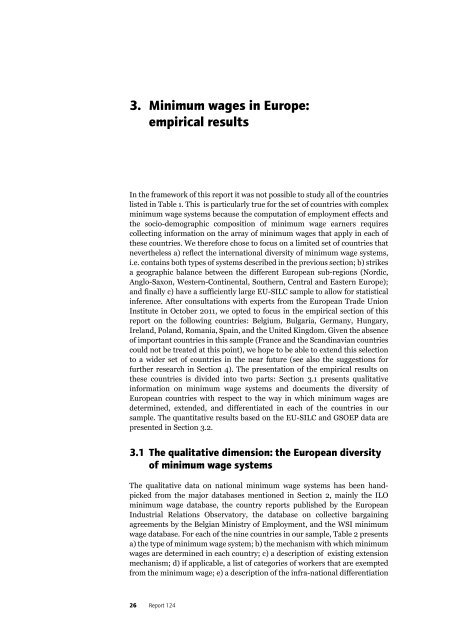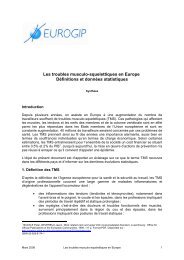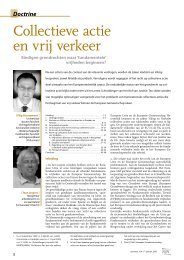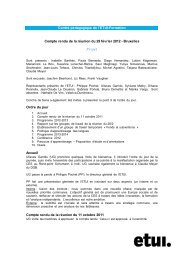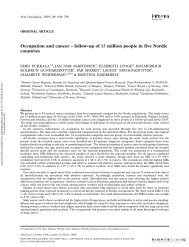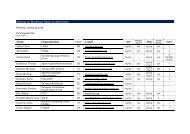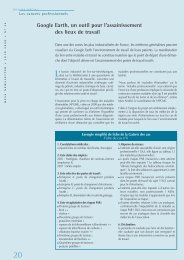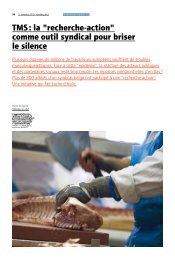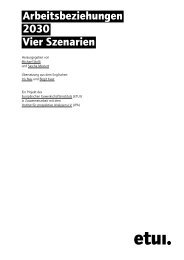Who earns minimum wages in Europe - European Trade Union ...
Who earns minimum wages in Europe - European Trade Union ...
Who earns minimum wages in Europe - European Trade Union ...
You also want an ePaper? Increase the reach of your titles
YUMPU automatically turns print PDFs into web optimized ePapers that Google loves.
3. M<strong>in</strong>imum <strong>wages</strong> <strong>in</strong> <strong>Europe</strong>:<br />
empirical results<br />
In the framework of this report it was not possible to study all of the countries<br />
listed <strong>in</strong> Table 1. This is particularly true for the set of countries with complex<br />
<strong>m<strong>in</strong>imum</strong> wage systems because the computation of employment effects and<br />
the socio-demographic composition of <strong>m<strong>in</strong>imum</strong> wage earners requires<br />
collect<strong>in</strong>g <strong>in</strong>formation on the array of <strong>m<strong>in</strong>imum</strong> <strong>wages</strong> that apply <strong>in</strong> each of<br />
these countries. We therefore chose to focus on a limited set of countries that<br />
nevertheless a) reflect the <strong>in</strong>ternational diversity of <strong>m<strong>in</strong>imum</strong> wage systems,<br />
i.e. conta<strong>in</strong>s both types of systems described <strong>in</strong> the previous section; b) strikes<br />
a geographic balance between the different <strong>Europe</strong>an sub-regions (Nordic,<br />
Anglo-Saxon, Western-Cont<strong>in</strong>ental, Southern, Central and Eastern <strong>Europe</strong>);<br />
and f<strong>in</strong>ally c) have a sufficiently large EU-SILC sample to allow for statistical<br />
<strong>in</strong>ference. After consultations with experts from the <strong>Europe</strong>an <strong>Trade</strong> <strong>Union</strong><br />
Institute <strong>in</strong> October 2011, we opted to focus <strong>in</strong> the empirical section of this<br />
report on the follow<strong>in</strong>g countries: Belgium, Bulgaria, Germany, Hungary,<br />
Ireland, Poland, Romania, Spa<strong>in</strong>, and the United K<strong>in</strong>gdom. Given the absence<br />
of important countries <strong>in</strong> this sample (France and the Scand<strong>in</strong>avian countries<br />
could not be treated at this po<strong>in</strong>t), we hope to be able to extend this selection<br />
to a wider set of countries <strong>in</strong> the near future (see also the suggestions for<br />
further research <strong>in</strong> Section 4). The presentation of the empirical results on<br />
these countries is divided <strong>in</strong>to two parts: Section 3.1 presents qualitative<br />
<strong>in</strong>formation on <strong>m<strong>in</strong>imum</strong> wage systems and documents the diversity of<br />
<strong>Europe</strong>an countries with respect to the way <strong>in</strong> which <strong>m<strong>in</strong>imum</strong> <strong>wages</strong> are<br />
determ<strong>in</strong>ed, extended, and differentiated <strong>in</strong> each of the countries <strong>in</strong> our<br />
sample. The quantitative results based on the EU-SILC and GSOEP data are<br />
presented <strong>in</strong> Section 3.2.<br />
3.1 The qualitative dimension: the <strong>Europe</strong>an diversity<br />
of <strong>m<strong>in</strong>imum</strong> wage systems<br />
The qualitative data on national <strong>m<strong>in</strong>imum</strong> wage systems has been handpicked<br />
from the major databases mentioned <strong>in</strong> Section 2, ma<strong>in</strong>ly the ILO<br />
<strong>m<strong>in</strong>imum</strong> wage database, the country reports published by the <strong>Europe</strong>an<br />
Industrial Relations Observatory, the database on collective barga<strong>in</strong><strong>in</strong>g<br />
agreements by the Belgian M<strong>in</strong>istry of Employment, and the WSI <strong>m<strong>in</strong>imum</strong><br />
wage database. For each of the n<strong>in</strong>e countries <strong>in</strong> our sample, Table 2 presents<br />
a) the type of <strong>m<strong>in</strong>imum</strong> wage system; b) the mechanism with which <strong>m<strong>in</strong>imum</strong><br />
<strong>wages</strong> are determ<strong>in</strong>ed <strong>in</strong> each country; c) a description of exist<strong>in</strong>g extension<br />
mechanism; d) if applicable, a list of categories of workers that are exempted<br />
from the <strong>m<strong>in</strong>imum</strong> wage; e) a description of the <strong>in</strong>fra-national differentiation<br />
26 Report 124


